Escaping to a Shared Experience
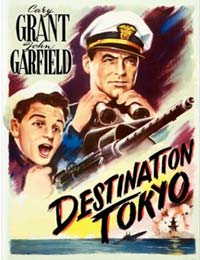 Destination Tokyo was one of many action movies produced by Hollywood during the war. The movies were patriotic and drew record attendance to theaters across the country.
Destination Tokyo was one of many action movies produced by Hollywood during the war. The movies were patriotic and drew record attendance to theaters across the country.
Most Americans worked long hours at their jobs and put in more time with volunteer work or other responsibilities during the war, but they still found time to escape into popular culture. Yet, in many cases, they couldn't escape since references to the war permeated magazines, movies, radio programs, comics and cartoons. Rather than providing an escape from the trials of home front life, many cultural outlets instead built a sense of community and shared experience. They proved that Americans were all in it together, struggling with rationing, worrying about loved ones fighting overseas, or adapting to a new job. Tapping a deep well of idealism and often laced with a bit of therapeutic humor, popular culture helped strengthen the bonds of what it meant to be an American. For most, it was not simply a feeling of "misery loves company" but of living in historic times and fighting an epic battle of good against evil.
Movie Theaters
Particularly in the early years of the war, a trip to the movies would have plenty of war references. A theater ticket usually bought access to two full-length feature movies, previews, a serial, cartoons and newsreels. About 75% of newsreels showed military, naval or other war-related activities.
For many, they were the only view of the air, land and sea battles that punctuated the war. The combat footage, expertly shot and shown in the distinct style of
The March of Time,
Fox Movietone, and
News of the Day, brought the war home for audiences across the country. At first, the coverage was heavily censored. For example, footage of the Pearl Harbor attack was not released by the government for a year. But by 1943 officials reversed course based on fears of waning civilian morale and allowed the release of films that showed the real carnage of war. Their hope was to shock Americans into strengthening their commitment to the war effort.
Footnote 1 Government Documentaries
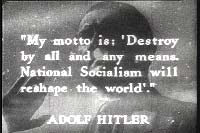 Director Frank Capra quoted Adolf Hitler in the OWI propaganda film series
Why We Fight, which drew a stark contrast between the values of Nazi Germany and America.
Director Frank Capra quoted Adolf Hitler in the OWI propaganda film series
Why We Fight, which drew a stark contrast between the values of Nazi Germany and America.
The government also funded documentary films about the war by talented and famous Hollywood directors. Among them was the 1942 John Ford film
The Battle of Midway, which covered the Japanese attack of American ships at Midway atoll that proved the pivotal naval battle of the war in the Pacific. Comprised mostly of authentic footage from the battle, it was dramatically narrated by actor Henry Fonda. The next year John Huston directed
Report from the Aleutians, a film that showed the daily life of American soldiers serving in the strategically important, but cold and barren, chain of Alaskan islands. In the film Huston looked closely at life on the island of Adak in the wake of the Battle of Dutch Harbor and showed a first-person perspective of an American bombing run against the Japanese. Another striking documentary was
Memphis Belle, directed by William Wyler in 1944, which dramatized the story of a harrowing B-17 bombing raid over Germany. In the process of showing the dangers, the film's narrator told the story of the ten crewmen as examples of simple average American boys doing a tough job. Meanwhile, Frank Capra directed a series of propaganda films for the Office of War Information (OWI) entitled
Why We Fight that, among other things, portrayed the Allies as partners in a struggle against evil.
Footnote 2 Feature Films and Cartoons
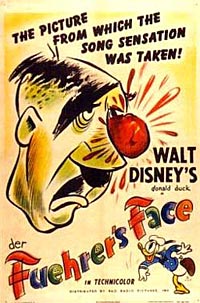 Disney character Donald Duck starred in a government sponsored animated film about wartime Germany that yielded a hit song based on flatulence. (Image courtesy Disney Online)
Disney character Donald Duck starred in a government sponsored animated film about wartime Germany that yielded a hit song based on flatulence. (Image courtesy Disney Online) Mainstream movies evolved during the course of the war. Early on, heroic and romantic war stories drew crowds and captivated audiences at the movie theaters with films such as
Casablanca starring Humphrey Bogart,
Flying Tigers with John Wayne, and
Destination Tokyo starring Cary Grant. Later, Hollywood executives sensed Americans were growing tired of war movies, resulting in the production of comedies, westerns and musicals. These included such films as the romp
Girl Crazy with Mickey Rooney and Judy Garland; the western
Tall in the Saddle, starring John Wayne; and the musical
Anchors Aweigh with Frank Sinatra.
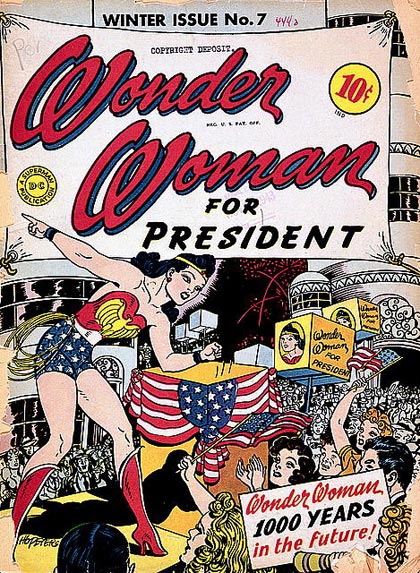 Wonder Woman, shown here on the cover of a comic book, also starred in a movie serial. (Image courtesy Library of Congress)
Enlarge image
Wonder Woman, shown here on the cover of a comic book, also starred in a movie serial. (Image courtesy Library of Congress)
Enlarge image About 25% of the 1,500 Hollywood movies released during the war were combat films. Along with the full-length features, viewers watched cartoons, some of which were government sponsored. Walt Disney produced some of these, including
Out of the Frying Pan and into the Fire starring Minnie Mouse as a housewife who saved bacon grease for the war effort. Meanwhile, Donald Duck got into the action in
Der Fuehrer's Face, in which he had a nightmare about the horrible life of working in one of Hitler's munitions factories.
Footnote 3 Regardless of the subject matter, Americans flocked to the theaters. By 1942 attendance reached 100 million people out of a total population of 135 million. As a result, box office receipts doubled from 1940 to 1945.
Footnote 4 Movie Serials
Much of the allure of going to the movies for children came from their excitement about movie serials. Despite questions from parents about what effect this had young minds, children were insistent about not missing the weekly installment of their favorite heroes. The Spider, Batman, Captain Marvel and Spy Smasher joined other freedom fighters to fight arch villains and agents of evil. Many of these heroes were based on the Superman theme. Among the adventures, in 1942
Batman began his pursuit of Dr. Daka, the Japanese superspy who was conspiring to seize control of America. The next year
The Masked Marvel went on the hunt for a Japanese spy named Sakima who was plotting to sabotage defense industries in the United States. And in 1944 the Nazis came face to face with superhero
Captain America, outfitted in red-white-and-blue tights. Even a female superhero got into the act of fighting the enemy.
Wonder Woman was wise, strong, fast, and beautiful in her red-white-and-blue costume as she fought Axis spies. Along with her superhuman skills, she employed fantastic gadgets such as bulletproof bracelets and a golden magic lasso. As if these weren't enough, she flew on her missions in an invisible plane that doubled as a time machine. Many movie serial superheroes also starred in comic books, which were wildly popular during the war.
Footnote 5Radio Programs
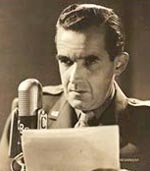 Radio news reporter Edward R. Murrow gave Americans eyewitness accounts of events such as the German bombing of Britain. (Image courtesy PBS)
Radio news reporter Edward R. Murrow gave Americans eyewitness accounts of events such as the German bombing of Britain. (Image courtesy PBS) Children's radio programming carried the familiar good versus evil theme that employed a moral tone similar to the righteous children's movie serials. In the end, good confronted evil and justice always prevailed. Along the way, children learned practical lessons in how they could help and be part of the action by planting Victory Gardens, buying war bonds, or collecting scrap metal. For example, listeners to the
Dick Tracy radio adventure program took a five-point pledge vowing to fight waste. Their assignment was "to save water, gas and electricity, to save fuel oil and coal, to save my clothes, to save Mom's furniture, to save my playthings." Participants saw their names placed on the Victory Honor Roll that the show's announcer promised would be read by General Dwight Eisenhower at his headquarters. Likewise, western hero Tom Mix fought spies and saboteurs every week during the war on his radio show and he implored his fans to keep up their home front efforts after Germany surrendered in May 1945: "We've shown Hitler and his gang that we know how to lick bullies and racketeers, but we've still got a big job to do...fighting the Japs."
Footnote 6
There was more to radio than children's programming. Radio news programs delivered reports from the battle fronts and from the centers of power. News pioneers such as Edward R. Murrow, William L. Shirer, Eric Sevareid, Robert Trout and Walter Cronkite brought moving stories of brutality, hardship and heroism to the living rooms of millions of Americans. Radio stations broadcast local programs educating neighbors how to use ration books or why they needed to grow a Victory Garden. National war bond drives and other campaigns brought big stars like Jack Benny, George Burns and Bob Hope to the radio. Big band music wafted through the airwaves with Duke Ellington, Glenn Miller, Tommy Dorsey and Benny Goodman. Many solo singers made it big after stints with big bands, including Frank Sinatra, Perry Como and Dinah Shore. The smooth sounds of Bing Crosby contrasted with the verve of Ella Fitzgerald and the power of Kate Smith. Of course, soap operas and melodramas couldn't be forced from the radio dial, even by war. Stalwarts such as
Stella Dallas,
Ma Perkins, and
Portia Faces Life kept housewives entertained while tending to the endless chores.
Footnote 7 Newspaper Editorial Cartoons
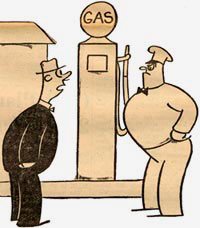 "Can't I just sniff around a little?" (Folder 5, Box 34, Defense Council Records, OSA)
"Can't I just sniff around a little?" (Folder 5, Box 34, Defense Council Records, OSA) Newspaper editorial cartoons poked fun at home front hardships such as conservation and rationing. One cartoon showed an earnest looking boy carrying his tricycle over his shoulder as he passed two women, one of whom says: "Here comes Junior--conserving rubber." Another one showed a desperate looking man asking a stern looking gas station attendant standing next to a gas pump: "Can't I just sniff around a little?" A third cartoon showed a boy standing in front of the an irate teacher and a principal holding the boy's sling shot while saying: "You get five demerits for plinking your teacher, and you are expelled from school for wasting rubber." (
War services cartoons)
Footnote 8
Many cartoons sympathized with the G.I. experience and explored the role of the expansion of women in the working world, particularly in factories. Thus, two astonished G.I.s looked on as a headless soldier walked by and one of the men said: "Frankly, I think they're overdoing these G.I. haircuts." Another showed two soldiers relaxing in a mess hall as one confided to the other: "I'm looking forward to the furlough, but I hate to think of eating my wife's cooking again." In another cartoon that displayed the shifting family responsibilities during wartime, a woman prepared for a factory job as her upset daughter held up a dirty towel and chastised: "Mother! Just look at what you did to one of our best guest towels!" Proving women were a match for men, a cartoon showed a group of energetic women standing in front of a number of exhausted and sobbing men in a munitions factory as the women told their boss: "We just settled a little argument about women's ability to turn out ammunition." (
G.I. and women's role cartoons)
Footnote 9
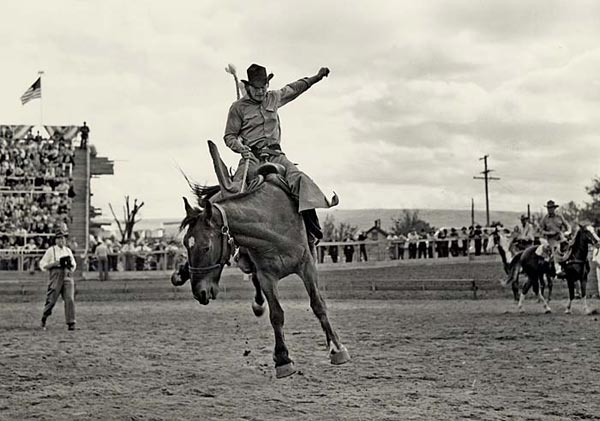 The Pendleton Round-Up, shown here in 1940, was one of many popular events that closed for part or all of the war. (Photo no. 1320, Highway Dept. Records, OSA)
Enlarge image
The Pendleton Round-Up, shown here in 1940, was one of many popular events that closed for part or all of the war. (Photo no. 1320, Highway Dept. Records, OSA)
Enlarge image Other cartoons ridiculed the enemy and pleaded with Americans to maintain their commitment to the cause. For example, one drawing showed sweating German and Japanese leaders lashed to a gigantic stick of dynamite with "Invasion" written across it as the caption implored: "Back the attack on the home front!" Another showed Hitler contemplating suicide as he stood over a table with a revolver on it and a reinforced door strains against the power of the "coming invasion" while the title reads: "Opportunity knocks." The perils of overconfidence and the resulting problems of absenteeism and production delays were portrayed in one drawing of two workers, one hung over and one drunk and holding a case of liquor, saying: "Whoopee, we just took Sicily and the war's over! Time to celebrate, pal!" Overconfidence also hit civilian protection efforts as one cartoon showed one civilian protection volunteer saying to another: "Aw! I'm going home-nothing's gonna happen now!" Behind the fence stood a huge criminal looking Axis agent holding a club with "sabotage" written on it as the title read "Just what he's waiting for." (
Enemy and overconfidence cartoons)
Footnote 10 Oregon Popular Culture Offerings
Oregonians augmented national popular culture with more of the local, homegrown variety. They participated in the pageants, contests, concerts, recitals, plays, speeches and other entertainments, many designed to promote war efforts such as selling war bonds to collecting Victory Books. Throughout the war young people flocked to juke joints and teen canteens to dance to their favorite tunes.
Oregonians also celebrated at local fairs, parades, festivals, circuses and carnivals, though many were curtailed during the war. For example, in 1942 the State Fair was scaled back to include only 4-H displays, livestock exhibits and 27 county displays. The next two fairs were suspended entirely, with the grounds leased to military units as a bivouac site. The Portland Rose Festival court carried on, as did the Pendleton Round-Up, with the exception of 1942 and 1943. Other events or attractions, such as the Oregon Shakespeare Festival in Ashland and Timberline Lodge at Mt. Hood, went on hiatus for most or all of the war. Despite gasoline and tire rationing, many Oregonians found a way to get to the beach to drink in the scenery and the popular culture of the coast at places such as Seaside. Others headed to the mountains to celebrate the winter culture romanticized by Bing Crosby's hit song White Christmas, with sleigh bells, skis, and hot apple cider.
Footnote 11Notes